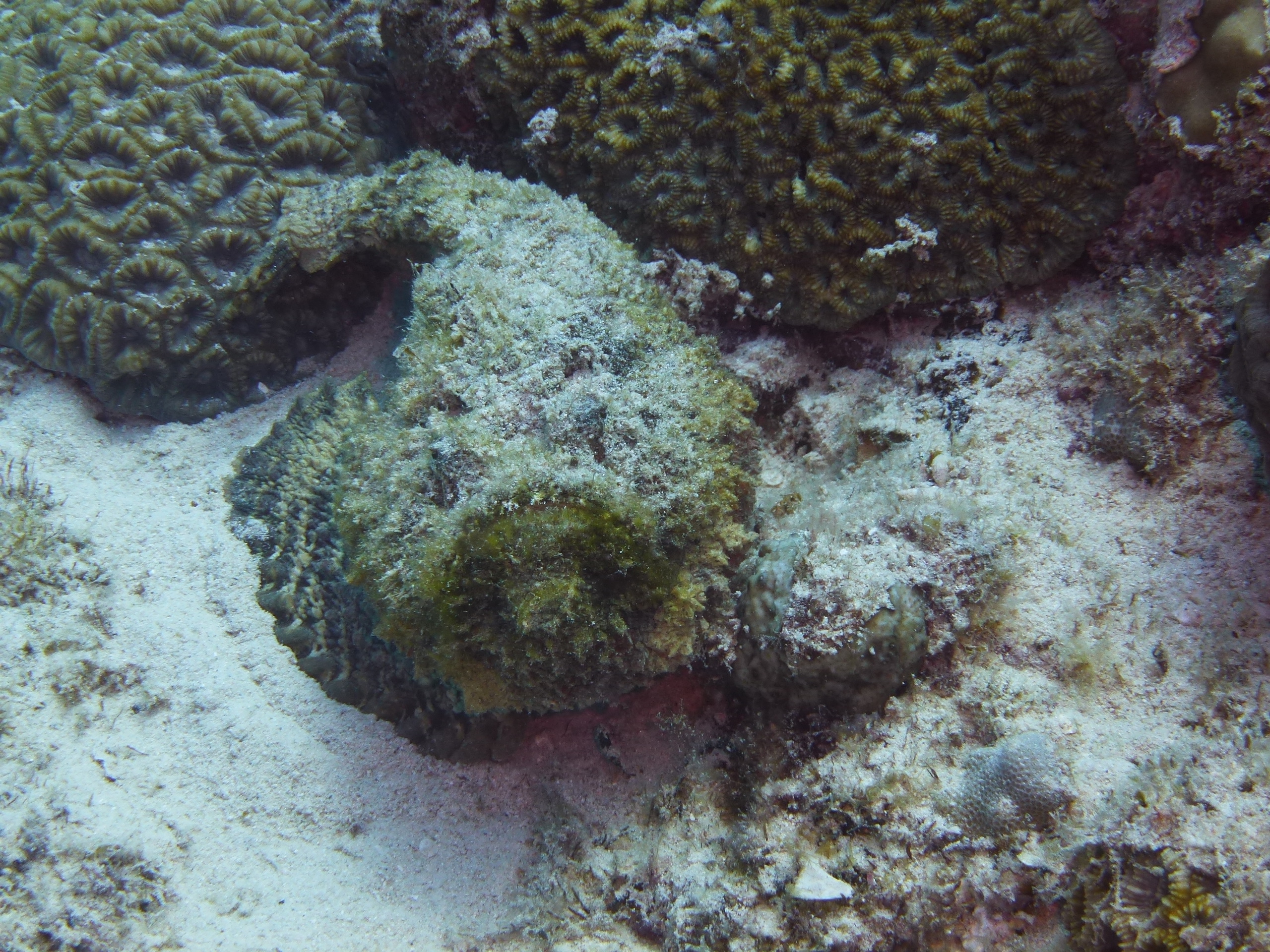or: Why Looking Properly Is Usually A Good Idea
In a case of not judging a book by its cover, there is a particular dive site that consistently reminds me to never stop exploring. Not that I need reminding.
Initially it appears to be one of the most boring parts of the underwater world.
It’s definitey not.
On descenending, you are greeted by a vast expanse of white sand with the occasional small outcrop of corals or rocks. There appears to be nothing else.
Even for coral people, this area doesn’t look particularly exciting. For fish people, it looks even worse. The area appears to be fairly devoid of any regularly moving life except for the occasional small school of baby cardinals (they look like tiny elongated goldfish with a stripe through their eyes) or various baby antheas (generally a bright electric blue with some equally bright yellow – they may be tiny yet they are not afraid to be seen) or dash-dot goatfish or half moon triggerfish (I like these ones, it looks like their tails have been painted to look like an orange moon on a white background).
It seems you are looking at a bit of an oceanic desert. Except there is a lot of water – obviously.
If you gave up here and went back to the boat, you would be missing one of the most interesting parts of this reef. It is teeming with life.
A closer look at one of the outcrops reveals a massive array of life. You just need to look a little bit harder than in other areas of the reef.
Two expert camouflagers are permanent residents in this area and are one of the main reasons this dive site is known as Poison Reef. If that’s not enough of an indication to not touch anything, a quick read about some of the local inhabitants would do it.
These two experts mimic stones so beautifully that they are easy to miss. Lacking a more imaginative name, one is the stonefish and the other is the scorpionfish – two of the most deadly fish, just from touch. The stonefish has no physically redeeming characteristics in terms of beauty unless you happen to like mottled rocks. The easiest way to spot them to me is by following a trail as they usually are at the bottom of corals or rocks. The second easiest way is to watch for eye movement. It can take a while.
The scorpionfish on the other hand, while looking fairly similar to the stonefish, has one amazing feature that is both beautiful and a useful aid in spotting it in the first place.
It has two brightly coloured pectoral fins (these are the fins on the side). It normally keeps them folded in so it too looks just like a stone. When it decides to move though, these fins resemble brightly coloured wings – the dominant colour is usually red or orange and then there are stripes of black, whites and yellows making a stunning pattern that is straight out of a comic book – it looks drawn on and transforms this rather unattractive fish into something that looks remarkable. And a lot easier to spot.
This part of the reef is also home to numerous moray eels. They come in a variety of sizes and colours too and my favourite is a white one thats mouth is yellow on the inside. You can see this one as they gulp in water. Lately all the eels seem to be a bit more active than usual so they have become easier to spot as they are swimming from one of their secret hiding places to another.
The easiest way to spot these is by letting your eyes adjust, looking over holes and watching as eels like to stick their heads out of them to watch what’s going on. They are like the nosy Neighbour peering out from behind the curtains, hoping not to be seen themselves.
Another favourite is a ribbon eel. The males are blue with a yellow stripe down their backs (there seems to be a theme here…) and the females are bright yellow. These are both a little easier to spot. Their movement through water is stunning to watch as it is like watching a ribbon move in the wind. Their children are little harder to spot since they are black and tend to hide a bit more.
None of these eels are poisonous though they would hurt if you happen to put your finger in its mouth. They wouldn’t be aiming on hurting you, it’s just a normal reaction for most living things that if you put your finger somewhere near or in their mouth, they’ll bite.
Now one of the coolest things to spot is the octopus. This is not something I’m particularly good at so today was a great diving day for me because I spotted two. Like the moray eels the easiest way to find them is to be patient and look around holes. They like to stick their heads out and then quickly back in because while they are also a bit like the nosy neighbour, they prefer not to be seen and will camouflage to match their environment. They can change colour incredibly quickly and what’s even more amazing, they can’t actually see colour themselves. What you’re really looking for is the movement rather than the octopus itself because spotting something that camoflages like this is even harder than spotting the stonefish as this one moves in a less cumbersome way.
Today I spotted one by this whack-a-mole / nosy neighbour movement and the other because I happened to see it swimming from one hole to another. I then looked into that hole and watched it change colour multiple times.
Now you would be forgiven for thinking you would only find things here by looking in holes. That’s not quite true. There are many different kinds of fish hiding in amongst the corals too. Some are also easy to spot if you happen to be close enough to be looking into the holes anyway. These make no effort to hide and swim about with wild abandon. Or that’s how it appears.
Others, you just have to get lucky.
This spot seems to be the home for quite a few baby fish. Not adolescents, actual babies.
I was at this particular dive site earlier in the week too and I was extremely lucky.
I spotted a baby lionfish.
Now these fish are dangerous too and are quite beautiful to look at as adults. They have 18 venomous spines in total, including 13 along its back. Their body looks fairly solid and tends to be striped in browns, whites, reds and creams and their various adornments look similar to feathers, feathers that pack quite a sting!
Their babies are stunning.
I’ve only seen one so I’m making a bit of an assumption.
The one I saw was a pale pink, no longer than from the top of your thumb to the knuckle, its pectoral fins spread as wings which were easily bigger than its body, its spines also feather-like – it appeared to be dancing on the current and drifting over a small piece of coral.
I watched it dance for about five minutes. I was mesmerized.
My reaction attracted one other diver who joined me to watch. We were then joined by another.
All spellbound.
Not bad for a reef that seems to have nothing.
* Thanks to Aurosonic for the title to this post.

